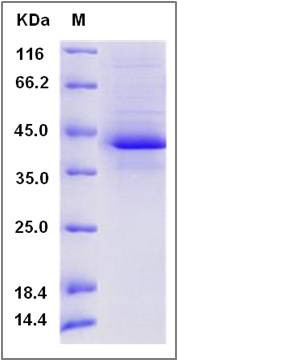Human FAM19A2 Protein (Fc Tag)
TAFA-2,TAFA2
- 100ug (NPP1268) Please inquiry
| Catalog Number | P11169-H01H |
|---|---|
| Organism Species | Human |
| Host | Human Cells |
| Synonyms | TAFA-2,TAFA2 |
| Molecular Weight | The recombinant human FAM19A2/Fc is a disulfide-linked homodimer. The reduced monomer comprises 361 amino acids and has a predicted molecular mass of 39.7 kDa. The apparent molecular mass of the protein is approximately 43 kDa in SDS-PAGE under reducing conditions. |
| predicted N | Glu |
| SDS-PAGE |  |
| Purity | > 79 % as determined by SDS-PAGE |
| Protein Construction | A DNA sequence encoding the human FAM19A2 (Q8N3H0-1) (Ala31-His131) was expressed, fused with the Fc region of human IgG1 at the N-terminus. |
| Bio-activity | |
| Research Area | Immunology |Inflammation / Inflammatory Mediator |Inflammatory Cytokines & Chemoki and Receptors |Chemokines and Receptors |Other Chemokine-related Ligands and Receptors |
| Formulation | Lyophilized from sterile PBS, pH 7.4 1. Normally 5 % - 8 % trehalose, mannitol and 0.01% Tween80 are added as protectants before lyophilization. Specific concentrations are included in the hardcopy of COA. |
| Background | FAM19A2 belongs to the FAM19/TAFA family. FAM19/TAFA family members are chemokine-like proteins. The biological functions of TAFA family members remain to be determined, but there are a few tentative hypotheses. First, TAFAs may modulate immune responses in the CNS by functioning as brain specific chemokines, and may act with other chemokines to optimize the recruitment and activity of immune cells in the CNS. Second, TAFAs may represent a novel class of neurokines that act as regulators of immune nervous cells. And third, TAFAs may control axonal sprouting following brain injury. Human FAM19A2 is 97% aa identical to mouse FAM19A2 and is expressed in the central nervous system (CNS), colon, heart, lung, spleen, kidney, and thymus, however its expression in the CNS is 50 to 1000 fold higher than in other tissues. FAM19A2 gene is a member of the TAFA family which is composed of five highly homologous genes that encode small secreted proteins. |
| Reference |
